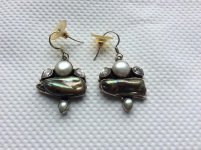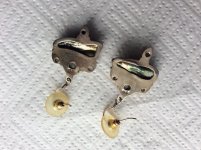Hi, I bought these earrings at a flea market. I love them, and have only recently wondered about possible value and origin.
I did some rummaging online and wonder if the main stones are abalone pearls?
The dark pearls are approx 20mm x 8mm (they have depth and protrude through the setting at the back)
The larger white pearls are approx 5mm diameter (these sit flush in the setting)
The smaller white pearls are tiny, approx 2mm
All the stones have the gritty tooth test.
The metal is .925 silver.
Any thoughts please?
Many thanks,
Lis
I did some rummaging online and wonder if the main stones are abalone pearls?
The dark pearls are approx 20mm x 8mm (they have depth and protrude through the setting at the back)
The larger white pearls are approx 5mm diameter (these sit flush in the setting)
The smaller white pearls are tiny, approx 2mm
All the stones have the gritty tooth test.
The metal is .925 silver.
Any thoughts please?
Many thanks,
Lis


